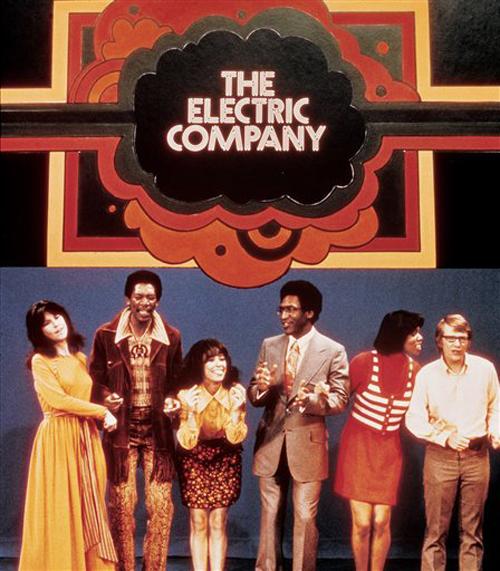New ‘Electric Company’ plugs kids into reading

In this image released by the Sesame Workshop, the original cast of the PBS program,”The Electric Company,” is shown. The 1970s cast included, Morgan Freeman, second left, Rita Moreno, third left and Bill Cosby, center. Johansen Krause, The Associated Press
Jan 16, 2009
Last updated on May 13, 2016 at 06:34 p.m.
NEW YORK – Watch out for silent e. That little stealth agent can turn a glob into a globe and a plan into a plane. That’s pretty hug, um, huge!
Or as they say on “The Electric Company,” silent e is the baddest ninja in town.
Yes, “The Electric Company” has been switched back on, plugged back into “the awesome power that lives inside of words.” Nearly four decades after a generation of youngsters powered up with a show that helped them learn to read, the airwaves are newly supercharged. (A two-hour preview airs Monday on the PBS Kids Go! program block, with weekly episodes starting Jan. 23; check local time.)
This “Company” has resurrected the “Hey, you guyyyyys!” rallying cry, the reading-is-cool gospel and the frolicsome approach to serious matters – such as the gigantically great difference between soft g and hard g.
Get The Daily Illini in your inbox!
But the rest is brand new, commingling lesson nuggets with full-fledged song-and-dance-sparked stories unfolding on the streets of New York. One favorite shooting location: a park in Manhattan’s Washington Heights area, with the brightly colored storefront of the Electric Diner (headquarters for Electric Company members) situated nearby.
Teenagers Keith, Lisa and Jessica, along with Jessica’s 20-year-old brother Hector, are united by their super-hero-worthy literacy skills, very useful for foiling the neighborhood Pranksters, who habitually display a comedic disregard for the power of words.
The literacy rate among the nation’s kids is at depths comparable to 1971, when the original “Electric Company” premiered. The reading ability of more than half of all fourth graders is below what it should be, with a pronounced literacy gap between low- and middle-income families. A revival of the show is overdue, says executive producer Karen Fowler.
“From grades one to three, you’re learning to read. From fourth grade on, you’re reading to learn,” she says. “So if you haven’t mastered the fundamentals by fourth grade, you are dealing with content that’s just going over your head.”
A nine-year veteran of Sesame Workshop, Fowler began pushing several years ago to get the “Company” running again. Production of the first season’s 35 episodes began last summer.
One major way of bringing this “Company” up to date: a hip-hop style that disguises the phonics fundamentals in rhythmic wordplay and choreography.
“Instead of kids singing songs with trashy lyrics, I want them singing, ‘Silent e! What a great discovery!'” says Fowler. “That’s my dream.”
Some of those lyrics and many of the scripts are written by Willie Reale (ree-AH-lee), the show’s co-executive producer. A past nominee for both an Oscar and Tony Award, Reale also received a Catherine T. MacArthur Foundation “genius grant” in recognition of his 52nd Street Project, a theater company he founded for inner-city children and ran for 18 years. In the meantime, he has written patently grown-up fare such as episodes of “Homicide: Life on the Street” and the current FX legal drama “Damages.”
An “Electric Company” episode makes unique writing demands, including a cluster of vocabulary words plugged unintrusively into the tale.
“They are introduced and defined in the dialogue, then reused four or more additional times,” he says. “And then the words are reinforced in what I call the ‘phonics commercials’ that live in between the narrative. It’s a rather complicated matrix of learning.”
And complicated to create.
“This is about solving a puzzle,” Reale says. “Make it fun, make the characters compelling and put the lessons across. It’s much trickier than any other work I’ve done.”
More episodes are planned and, come fall, the series will air every weekday. But there’s more to the new “Electric Company” than TV.
Conceived as a multimedia literacy campaign, the TV show will be supplemented by community-based outreach activities in 20 cities. And a robust interactive online environment full of games and videos awaits youngsters just a few mouse clicks away.
The Web site “allows kids to connect with the show and connect with one another,” says Scott Cameron, director of education and research.
It’s unlikely the revived “Electric Company” will match the 780 episodes of the original TV series, says Cameron, nor would that make sense in the Internet age.
“Already, there’s a lot of ‘Electric Company’ to go around,” he points out.
“It’s the clubhouse that 7-year-olds want to be at,” Karen Fowler says. “But first the kids have to find it. We have a big job in front of us right now, to build that playground buzz. That’s how we get to the kids who need it most.”





